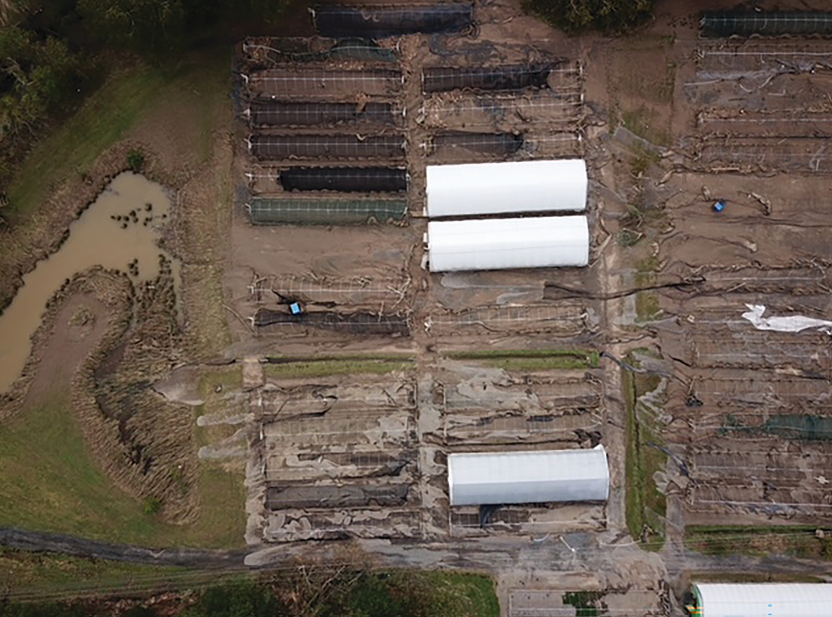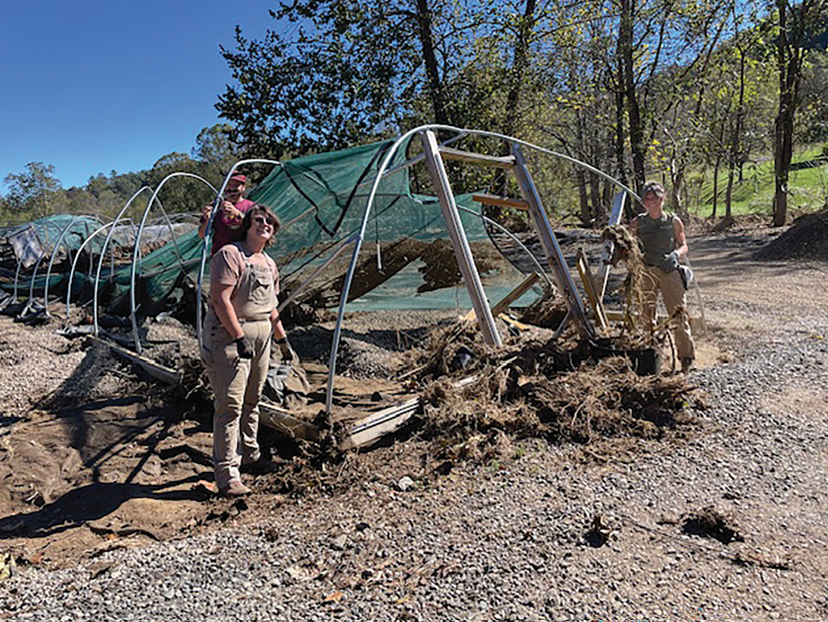
The southeastern United States has been ravaged this fall by back-to-back hurricanes that made landfall less than two weeks and about 250 miles apart on Florida’s Gulf Coast.
Hurricane Helene, a Category 4 storm, made landfall late Sept. 26 before tearing through Georgia, South Carolina, North Carolina, Tennessee and Virginia. The storm killed more than 230 people, wiped out towns, destroyed roads and left communities without power, internet access or cellphone service.
Hurricane Milton made landfall Oct. 9 as a Category 3 storm before speeding across the Florida peninsula into the western Atlantic. As of Oct. 15, Milton killed at least 24 people.
Here’s how these hurricanes have affected the horticulture industry, how those affected can get assistance and what those in the industry can do to help.
Hurricane Helene in North Carolina
The devastation from Helene was particularly bad in and around Asheville in North Carolina. The Associated Press reports that western North Carolina suffered relatively more devastation because the higher elevations and cooler air of the Appalachian Mountains caused even more rain to fall — in mountain towns already built in valleys that leave them vulnerable to flooding.
In a matter of hours Sept. 27, an estimated four feet of devastating floodwaters from Helene swept through native plant supplier Carolina Native Nursery in western North Carolina, wiping out 90% of its inventory and causing significant damage to its infrastructure.
“We estimate 90% of our plants are on their way to the Atlantic Ocean at this time,” said Bill Jones, president of Carolina Native Nursery, in a video posted to Facebook.
“Western North Carolina, the upstate of South Carolina, eastern Tennessee is going to be in redevelopment for years,” he added.
The nursery is clearing debris, cleaning out greenhouses and beginning the process of recovery but said it will be a year “before we are up and running at full ‘Carolina Native’ speed.”
The nursery has received extensive support in the weeks since the disaster. A GoFundMe for the Nursery raised more than $100,000, including a $7,955 donation from Izel Native Plants, for its rebuilding efforts.
Extension Master Gardener Volunteers of Caldwell County hosted a native plant sale, with 100% of the proceeds going to Carolina Native Nursery. Izel Native Plants donated 15% of its revenue for a week of orders.
The nursery also received support from Northcreek Nursery in Delaware, Pinelands Nursery in New Jersey, Kind Earth Growers in Pennsylvania, Beauty Berry Gardens in Georgia, Saturnia Farms in North Carolina, Williams Plantworks in North Carolina, Flowering Earth Natives in North Carolina and Johnny Nobles from the Farm Bureau.
Others who have volunteered or provided help include Aldridge Electrical Contracting, Saturnia Farm, Bashavia Gardens, Super Bloom Natives, Sprigg Landscaping, Reynolda, Greater Scapes Landscape and Lawncare, Landmark Landscapes, Tanager Plants, Evergreen of Kingsport and U.S. Fish and Wildlife Service.

“…The support from our friends, colleagues, the native plant community and so many more continues to be overwhelming,” Jones said. “It is a very emotional time for everyone in western NC — me too. But the incredible comradery and uplift we have seen, felt, observed and shared is awe-inspiring.”
Green industry businesses throughout western North Carolina sustained heavy damage, and many are closed until further notice as they deal with the aftermath of the storm.
“We are strong, we are determined, we are family, we are community,” Raymond’s Garden Center in Hendersonville wrote on Facebook. “We all WILL get thru this.”
Hurricane Milton in Florida
Orange Lake Nursery, an online plant nursery in Lorida, Florida, specializing in rare and exotic plants, said the business “lost everything” due to a tornado the afternoon of Oct. 9, ahead of Milton’s landfall.
Hurricanes and tropical storms can also produce tornadoes, most often occurring in thunderstorms embedded in rain bands well away from the center of the hurricane, according to the National Oceanic and Atmospheric Administration’s National Hurricane Center.
“The business is destroyed. We are without power & we don’t know for how long. We will reach out & be in touch as soon as possible,” the nursery wrote on Facebook Oct. 9. “Tornado just came out of nowhere. I have never been so scared…We are so grateful for your prayers & patience. Other than that, I am not sure what we need or where to even start.”
How to help horticulture businesses after Helene
Donation options for both Helene and Milton recovery include the North Carolina Disaster Relief Fund (pay.payitgov.com/ ncdonations) and the American Red Cross (redcross.org/donate/dr/hurricanes-milton-helene.html).
“After a disaster, cash is often the best way to help as it provides the greatest flexibility for these reputable organizations working on the ground to purchase exactly what is needed,” FEMA said.

Hurricane assistance and recovery
In light of rampant rumors related to hurricane recovery, FEMA created a website, fema.gov/disaster/current/hurricane-helene/rumor-response, to respond with factual information.
Visit disasterassistance.gov to apply for FEMA assistance. You can check the status of your application at the same website or by calling the FEMA Helpline at 800-621-3362.
There is also state-by-state information and assistance for recovery:
- Helene North Carolina: fema.gov/disaster/4827
- Helene Florida: fema.gov/disaster/4828
- Helene South Carolina: fema.gov/disaster/4829
- Helene Georgia: fema.gov/disaster/4830
- Helene Tennessee: fema.gov/disaster/4832
- Helene Virginia: fema.gov/disaster/4831
- Milton: fema.gov/disaster/current/hurricane-milton and floridadisaster.org/disaster-updates/Hurricanemilton
Homeowners and small business owners can apply for low-interest disaster loans from the U.S. Small Business Administration in declared major disaster areas to help with home repair or replacement, personal property, vehicles, mitigation, business losses and working capital for small business and private nonprofits. For information and to apply, visit sba.gov/disaster.
In Florida, The Agriculture and Aquaculture Producers Natural Disaster Recovery Loan Program was established within the Florida Department of Agriculture and Consumer Services to make low-interest or interest-free loans to agricultural and aquaculture producers who have experienced damage from a declared natural disaster. For more information and to apply, visit bit.ly/fl-ag-loan.
Additional recovery resources are available from:
- North Carolina Nursery and Landscape Association (ncnla.com/page/hurricane)
- North Carolina Department of Agriculture and Consumer Services (ncagr.gov/emergency-programs/disaster-information)
- Florida Nursery, Growers and Landscape Association (fngla.org/advocacy/disaster-assistance)
- Georgia Department of Agriculture (agr.georgia.gov/hurricane-response-helene and agr.georgia.gov/hurricane-response-milton).
Latest from Produce Grower
- The Growth Industry Episode 3: Across the Pond with Neville Stein
- PG CEA HERB Part 2: Analyzing basil nutrient disorders
- University of Evansville launches 'We Grow Aces!' to tackle food insecurity with anu, eko Solutions
- LettUs Grow, KG Systems partner on Advanced Aeroponics technology
- Find out what's in FMI's Power of Produce 2025 report
- The Growth Industry Episode 2: Emily Showalter on how Willoway Nurseries transformed its business
- 80 Acres Farms expands to Georgia, Texas and Colorado
- How BrightFarms quadrupled capacity in six months





